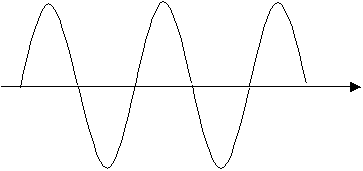 |
1.
a. Explain with the aid
of 2 diagrams the meaning of the terms direct current and alternating
current.
b. Describe the advantages of a.c. over d.c. for the transmission of mains electricity
2. Consider the following a.c. waveform for voltage against time. Using a scale of 1 Volt to 1 cm, calculate and label on the graph the following:
a. The peak voltage
b. The peak-to-peak voltage

3.
 Repeat
for this a.c. trace:
Repeat
for this a.c. trace:
4. Use Breithaupt to help you explain carefully the meaning of the terms r.m.s. voltage and r.m.s current for a sinusoidal wave form. Calculate r.m.s. voltages for questions 2 and 3.
5. Mains electricity can have an r.m.s. value of 240V calculate the peak voltage and the peak-to-peak voltage of a.c. main.
6. Repeat for 230V and for 110V
1. Explain how this can be used both
a. As a d.c. voltmeter
b. As an a.c. voltmeter
2. Describe the function of the following oscilloscope controls:
a. Y-gain
b. Timebase
3. The first diagram on this sheet is now the output trace of an oscilloscope. If the Y-gain is set to 2 V/cm and the timebase is set to 5ms/cm calculate:
a. The time period of the a.c waveform (the time taken to make one complete wave ie one complete up and one complete down again)
b. The frequency of the a.c wavetrace (you’ll need to learn and remember a formula that connects frequency to time period)
c. The peak voltage
d. The peak-to-peak voltage
e. The r.m.s voltage.
f.
Repeat question 3. but for the second diagram on this page if the Y-gain
was set to 0.5Vcm-1 and the timebase was set to 0.1ms cm-1